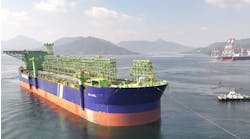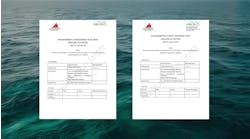Gjallar Ridge well sets operating benchmarks, despite disappointing outcome
In July, Saga Petroleum completed the drilling of exploration well 6704/12-1 on the Gjallar Ridge. The water depth, 1,352 meters, was the deepest in which a well has yet been drilled in Norway. At 400 km from the coast of mid-Norway, it is one of the farthest yet drilled from land. The well was the first in deepwater for both Saga, and the drilling contractor, Saipem.
Saga's hopes for the well were disappointed since no hydrocarbon discovery was made. Although the well was unsuccessful in terms of making a discovery, it can lay claim to being a model drilling operation, thanks to a meticulous process of planning and implementation.
Important objectives from the start were to reduce costs, and ensure a safe operation both for those involved and for the environment. In all three respects, the well was successful. The previous five deepwater wells drilled in Norway have all achieved satisfactory performances from the safety and environmental point of view, not least thanks to the Norwegian Deep-Water Program, through which the operators involved in deepwater wells - BP, Norsk Hydro, Statoil, Shell, and Saga - have worked together to prepare the groundwork in terms of environmental knowledge and equipment preparation.
Drilling time
The main component in the cost for an exploration well is the number of days the rig is on hire - in Saga's case, the period from mobilization of the semisubmersible Scarabeo 5 rig to the North Sea, to the time it was handed over to the next operator. This required 58.4 days, including a visit to Stavanger. The actual drilling period was just under 45 days.
Total downtime was only 10%, compared with a typical 20-30% for an exploration well in a conventional water depth. Although the final figure for the well cost is not yet available, it is expected to come in some 20% under budget.
The Gjallar Ridge well was a rank wildcat, some 75 km from the nearest well, Statoil's Vema Dome. It was located on production license 215, which covers four blocks in the Norwegian Sea and was awarded to Saga in the 15th licensing round in 1996.
The company, whose partners on the license are Conoco, Mobil, Norsk Hydro, and Statoil, originally planned to drill it in May 1998, and set up a deepwater drilling team in October 1997. Because of problems with the availability of Scarabeo 5, a heavy-duty fourth-generation dynamically positioned (DP) rig, the well was first postponed to August 1998 and then put back again to May 1999.
Though frustrating, the delay had the benefit that more detailed seismic analysis could be undertaken, on the basis of which the course of the well was changed from deviated to vertical, lopping 900 meters off the total length and reducing the drilling time accordingly.
Project ownership
Saga finished planning the well last summer, but because of the delays in the drilling program, planning was picked up again in early 1999. To optimize the planning process and make further improvements, the company engaged John de Wardt to apply his Lean Drilling program. This is a planning method based on giving "ownership" of the project to all involved parties, in the operator, drilling contractor and service companies, both offshore and onshore.
Each party is required to take full responsibility for their input, both in the planning and execution phase, in contrast to the usual approach in which "ownership" is concentrated mainly on those in charge in the operating company. De Wardt's method also puts great emphasis on risk management and contingency planning. He was assisted by Bill Henderson, a facilitator.
BP had a very positive experience using de Wardt's method on its deepwater Barden well. For Saga, which had not used it before, a significant change of culture was required to implement the method, but the effort proved worthwhile and made a large contribution to the reduced cost, according to Flemming Stene, Saga's Senior Drilling Engineer for the well.
All operations involved in drilling the well, from rig mobilization to handover, were analyzed in detail and some 400-500 constituent activities identified. Each was broken down into 15-minute elements. Points at which matters might go wrong were identified and contingency plans prepared. The original plan from 1998, based on other deepwater wells, estimated a duration of 100 days. This plan was optimized by Saga to 72 days, and then reduced by the improved planning process to a project target of only 57 days. The eventual duration was 58.4 days, which included nine days of additional work.
Difficult geology
One of the biggest challenges for a deepwater well is posed by the unconsolidated nature of the shallow formations. The period when something is most likely to go wrong is when the upper section is being drilled through these formations, and the blowout preventer (BOP) and riser run. Several of the previous deepwater wells had to be respudded, including Statoil's Vema Dome well which was respudded twice.
This phase of the well was analyzed thoroughly, Stene says. The experience of previous deepwater wells, not just in Norway, was investigated closely, and specialists who had been involved in them were consulted. Analysis of the shallow formations indicated the likely presence of a 600-meter layer of ooze, as a result of which it was decided to use a very strong conductor casing - 36-in ID with a 1.5-in wall thickness - to support the riser and BOP.
The rig was mobilized from North Sea block 34/7 in the Tampen area. It first had to call at Stavanger to take on a 15,000 psi blowout preventer (BOP). Modifications had been made to the BOP which meant some testing had to be performed before using it. The DP Class III rig had previously upgraded the DP reference system, and its first task on arriving on location was to calibrate the system. Altogether, mobilization and DP calibration took 8.3 days.
Spudding took place on 4 June. First, the pilot hole was drilled, in the course of which data was collected through measurement while drilling (MWD) and sonic sensors run in the drillstring. Then 42-in. by 36-in. hole was drilled to 1,473 meters (all depth figures are calculated from the rotary table), the conductor was run and cemented, the 26-in. hole drilled and 20-in casing set at 2,162 meters, below the loose sediments.
Tophole operations
The riser and BOP were then run, during which process some remedial cementing had to be carried out. From spudding to running the BOP took 11.6 days. "The period of open water operations is a risky period, but we got the casing run in time, after which the formation became a little unstable," says Stene. This part of the operation was successful due to detailed planning.
A small problem arose during the running of the BOP which meant it had to be pulled and some procedures changed. However, the problem was spotted when only five joints of riser had been run out of the total of about 70, so little delay was caused. "But, had we not had such a strong focus on BOP mobilization as part of the planning process, we would have had to pull the BOP from the seabed," Stene says. "So it's fair to say the planning process saved us a full round trip where the BOP was concerned."
Between drilling the tophole section and running the riser, cuttings samples brought to the top of the well from different levels in the tophole were collected by the remotely operated vehicle ( ROV) at the seabed using a specially designed can. This had not been done on any of the previous deepwater wells in Norway but provided an important input for geologists with respect to dating of the shallower sediments.
Once the riser and BOP had been set, drilling continued with 17-in. hole, rather than the usual 17.5-in. This was due to a restriction inside the 20-in casing in which a landing shoulder had been mounted in case problems arose and made it necessary to run 16-in liner, Stene says.
The 13 3/8-in. casing was run and cemented at 2,377 meters. The 12 1/4-in. hole was drilled and logged and 9 5/8-in. liner run and cemented at 2,849 meters. Liner, rather than the more normal casing, was used, as it had been decided during the planning phase that it would both take less time and entail less risk while running through the BOP. The choice was available because the 13 3/8-in. casing could take the maximum pressure expected. During both drilling and abandonment of the well a day or so was saved thanks to this choice.
Drilling then continued with 8 1/2-in hole, and planned total depth was reached at 3,877 meters 31 days after spudding. Based on stratigraphy it was decided to drill to a new total depth (TD) at 4,103 meters, which was reached after 35 days. In the additional section, a further core was cut and logging carried out. The well was then permanently plugged and abandoned, a process which took 5.3 days, and the rig moved to a new location south of the Norne Field where it was handed over to Saga licence PL 213 on 24 July.
Finding the right mud weight is another key challenge in deepwater wells. On the one hand, the formation strength is generally lower than with wells in conventional water depths, while the weight of mud in the much longer riser is greater. An additional difference is the greater risk of hydrate formation due to the colder seabed temperatures - in the case of Gjallar Ridge - 2 ° C. To meet this challenge, a special mud with a high potassium and sodium content was developed. It was not possible to use it in the 17-in. hole, as the weight was too great. It was used in the 12-in. and 8 1/2-in. sections and there were no problems of hydrate formation.
A sea current monitor was installed on the rig to ensure that the currents did not become strong enough to cause problems for the riser. In fact, surface currents, which in that region can flow at up to 1.4 meters/sec, got no higher than 0.5 meters/sec.
Wave heights of 17.5 meters can occur in this area in 100-year conditions - a wave monitor was also used - but, the sea was calm and weather conditions very good, Stene says. Conditions in the Gjallar Ridge area tend to be much worse in the winter.
The planning process also ensured that the operation went according to expectations from a logistical point of view. This was especially important, as it took supply boats 18-20 hours to reach the well location from the base at Sandnessj en. In addition, a lot of equipment had to be transported to Sandnessj en from Stavanger, where many of the service companies are based. This involved a three-day journey by road. One person was placed in control of all logistics operations, and a tracking system was used so that the location of all items of equipment was known at all times.
This was possibly the last deepwater well on the Norwegian continental shelf for a long period. The results from this well prove that deepwater wells can be drilled efficiently and cost-effectively, despite the significant challenges which have to be overcome, Stene says.


